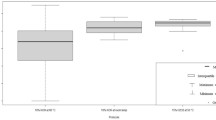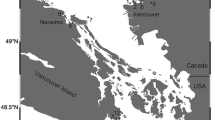Abstract
While whole sediment toxicity tests with macrofaunal polychaetes are well developed and standardized, they are oftentimes not very sensitive to environmental contaminants. Meiofaunal polychaetes, however, are sensitive to contaminants, easy to culture, and representative of the interstitial habitat. These are desirable attributes for ecotoxicological assessments of marine and estuarine sediments. The meiofaunal polychaete, Dinophilus gyrociliatus Schmidt, 1857, is a cosmopolitan species that has become a useful tool for ecotoxicological assessments, particularly for its use in toxicity testing with sediment pore waters. Due to its short life cycle it is suitable for sublethal toxicity tests, with egg production by the females as a sensitive endpoint, which can be assessed in a 7-day exposure period. Toxicity assessments of pore waters from an industrialized bay in Texas, U.S.A., and of pore waters from sediments spiked with nitroaromatic explosives, demonstrated that the D. gyrociliatus reproduction endpoint was consistently among the most sensitive, when compared to early-life stage tests with several other marine species, including macro-algae, sea urchins and fish. There was also excellent agreement among the results of porewater tests with D. gyrociliatus, nauplii of the meiofaunal copepod, Longipedia americana, and embryos of the sea urchin, Arbacia punctulata in a survey with pore waters extracted from sediments collected in the vicinity of an oil platform in the Gulf of Mexico, where metals were the primary contaminants of concern.
Access this chapter
Tax calculation will be finalised at checkout
Purchases are for personal use only
Preview
Unable to display preview. Download preview PDF.
Similar content being viewed by others
References
Anderson, B. S., J. W. Hunt, B. M. Phillips, S. Tudor, R. Fairey, J. Newman, H. M. Pluckett, M. Stephenson, E. R. Long & R. S. Tjeerdema, 1998. Comparison of marine toxicity test protocols for the amphipod Rhepoxinius abronius and the polychaete Nereis (Neanthes) arenaceodentata. Envir. Toxicol. Chem. 17: 859–866.
(ASTM) American Society for Testing and Materials, 1988. Standard practice for conducting acute toxicity tests with fishes, macroinvertebrates and amphibians. Designation E729–88. In ASTM Annual Book of Standards, Vol. 11. 04. American Society for Testing and Materials, Philadelphia (PA): 1–19.
(ASTM) American Society for Testing and Materials, 1990. Standard guide for conducting solid-phase 10-day static sediment toxicity tests with marine and estuarine infaunal amphipods. Designation: E 1367–90. In ASTM Annual Book of Standards, Vol. 11. 04. American Society for Testing and Materials, Philadelphia (PA): 1–24.
Bridges, T. S. & J. D. Farrar, 1997. The influence of worm age, duration of exposure and endpoint selection on bioassay sensitivity for Neanthes arenaceodentata (Annelida: Polychaeta). Envir. Toxicol. Chem. 16: 1650–1658.
Carr, R. S. & 1998. Sediment porewater testing. In Clesceri, L. S., A. E. Greenberg & A. D. Eaton (eds), Standard Methods for the Examination of Water and Wastewater, Section 8080, 20th edn., American Public Health Association, Washington (DC): 8–37 to 8–41.
Carr, R. S. & D. C. Chapman, 1992. Comparison of solid-phase and pore-water approaches for assessing the quality of marine and estuarine sediments. Chem. Ecol. 7: 19–30.
Carr, R. S. & D. C. Chapman, 1995. Comparison of methods for conducting marine and estuarine sediment porewater toxicity tests–extraction, storage, and handling techniques. Arch. envir. Contam. Toxicol. 28: 69–77.
Carr, R. S. & D. C. Chapman, C. L. Howard, J. M. Biedenbach, 1996b. Sediment quality triad assessment survey of the Galveston Bay, Texas system. Ecotoxicology 5: 341–364.
Carr, R. S., D. C. Chapman, B. Presley, J. Biedenbach, L. Robertson, P. Boothe, R. Kilada, T. Wade, P. Montagna, 1996a. Sediment porewater toxicity assessment studies in the vicinity of offshore oil and gas production platforms in the Gulf of Mexico. Can. J. Fish. aquat. Sci. 53: 2618–2628.
Carr, R. S. & M. Curran, M. Mazurkiewicz, 1986. Evaluation of the archiannelid Dinophilus gyrociliatus for use in short-term life-cycle toxicity tests. Envir. Toxicol. Chem. 5: 703–712.
Carr, R. S. & E. R. Long, H. L. Windom, D. C. Chapman, G. Thursby, G. M. Sloane, D. A. Wolfe, 1996c. Sediment quality assessment studies of Tampa Bay, Florida. Envir. Toxicol. Chem. 15: 1218–1231.
Carr, R. S. & M. Nipper, 2000. Toxicity of marine sediments and pore water spiked with ordnance compounds. Final report prepared for Naval Facilities Engineering Service Center, Port Hueneme, CA, Contract report CR 01-001-ENV, Naval Facilities Engineering Command, Washington, DC, U.S.A., 34 pp, 5 appendices, 5 attachments. http://enviro.nfesc.navy.mil/erb/erb_a/restoration/fcs_area/con_sed/MarineSed2000.pdf.
Carr, R. S. & J. Williams, C. Fragata, 1989. Development and evaluation of a novel marine sediment pore water toxicity test with the polychaete Dinophilus gyrociliatus. Envir. Toxicol. Chem. 8: 533–543.
Environment Canada, 1990. Guidance Document on Control of Toxicity Test Precision Using Reference Toxicants. Environmental Protection Series, Ottawa, Ontario, Canada. 85 pp.
Hooten, R. & R. S. Carr, 1998. Development and application of a marine sediment pore-water toxicity test using Ulva fasciata zoospores. Envir. Toxicol. Chem. 17: 932–940.
MacDonald, D.D., R. S. Carr, F. D. Calder, E. R. Long & C. G. Ingersoll, 1996. Development and evaluation of sediment quality guidelines for Florida coastal waters. Ecotoxicology 5: 253–278.
Nipper, M., R. S. Carr, J. Biedenbach, R. Hooten & K. Miller, 2002. Toxicological and chemical assessment of ordnance compounds in marine sediments and pore waters. Mar. Pollut. Bull. 44: 789–806.
SAS Institute Inc., 1989. SAS/STAT® User’s Guide, Version 6, 4th edn., Version 6, Volume 2. SAS Institute Inc., Cary (NC). 846 pp.
SAS Institute Inc., 1992. SAS/LAB® Software: User’s Guide, Version 6, 1st edn. SAS Institute Inc., Cary (NC). 291 pp.
Author information
Authors and Affiliations
Editor information
Editors and Affiliations
Rights and permissions
Copyright information
© 2003 Springer Science+Business Media Dordrecht
About this paper
Cite this paper
Nipper, M., Carr, R.S. (2003). Recent advances in the use of meiofaunal polychaetes for ecotoxicological assessments. In: Sigvaldadóttir, E., et al. Advances in Polychaete Research. Developments in Hydrobiology, vol 170. Springer, Dordrecht. https://doi.org/10.1007/978-94-017-0655-1_33
Download citation
DOI: https://doi.org/10.1007/978-94-017-0655-1_33
Publisher Name: Springer, Dordrecht
Print ISBN: 978-90-481-6361-8
Online ISBN: 978-94-017-0655-1
eBook Packages: Springer Book Archive




